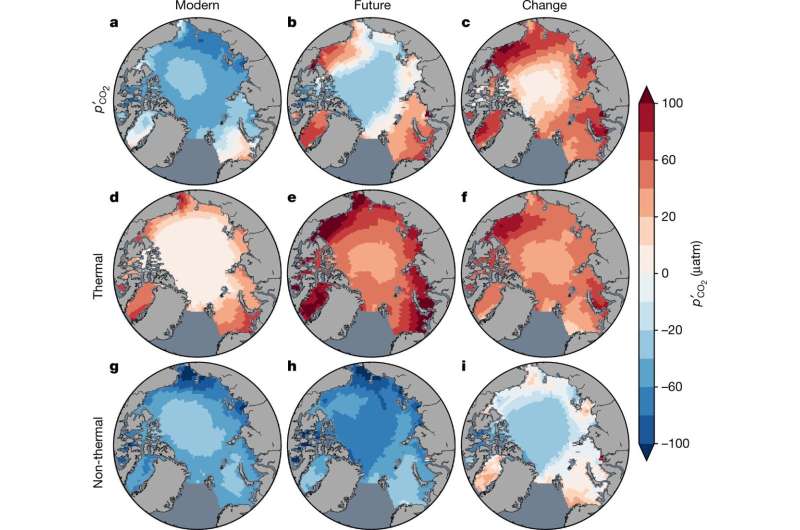Future summer p′CO2 is dominated by warming, particularly in shelf seas. a–i, Arctic maps of the summer anomalies of total pCO2 (a–c), the thermal component (d–f) and the non-thermal component (g–i) are shown for the CMIP5 mean (RCP8.5) as decadal averages for 2006–2015 (modern; a,d,g), 2091–2100 (future; b,e,h) and their difference (c,f,i). The summer anomaly is the average of the monthly anomalies over the three summer months (June, August, September). The components are from the Taylor expansion. The non-thermal component can be further decomposed into its various contributions, as discussed later, showing for instance that its reduction on the shelves is mostly from reduced influence of CT. Credit: Nature (2022). DOI: 10.1038/s41586-022-05205-y
A trio of researchers from CEA Saclay, Sorbonne Université-CNRS-IRD-MNHN and the Alfred Wegener Institute, respectively, has found evidence that peak ocean acidification in the Arctic Ocean may shift from winter to summer by 2100. In their paper published in the journal Nature, James Orr, Lester Kwiatkowski and Hans-Otto Pörtner describe their study of acidification of the Arctic Ocean in the future. A News and Views piece in the same journal also outlines their findings.
Prior research has shown that for a host of reasons, ocean acidification in the Arctic Ocean is greatest during the later winter months. This has been attributed to multiple factors such as water temperature differences, water pH differences and the rate at which phytoplankton pull carbon dioxide from the water. But this may change, according to this new study.
Acidification of the world's oceans is happening due to the increase in carbon dioxide in the atmosphere. As the carbon dioxide in the air meets the water, chemical reactions make the water more acidic, similar to the way soft drinks become more acidic when carbon dioxide is added to create bubbles. Prior research has also shown that acidification of the oceans is not constant—rates go up and down in any given region due to a number of factors. Researchers have also found differences based on region—some parts of some oceans are becoming more acidic faster than others. In this new effort, the researchers wondered about the acidification process in the Arctic Ocean—its cold temperature suggests things would be different than in the tropics or even in the mid-ocean.
To learn more about acidification in Arctic Ocean, the researchers studied 27 Earth system models that have been built over many years to simulate interactions between carbon dioxide in the air and the world's oceans. They focused most specifically on changes occurring in the Arctic Ocean. The simulations showed that if carbon dioxide emission levels are not reduced, acidification will accelerate, most particularly in the summer. This, they suggest, will come about due to increases in both air and ocean temperatures, resulting in increases in sea-ice retreat. The rate of increase in the summer, they also found, will surpass the rate of increase in the winter months, leading to peak acidification switching to the summer months.
More information: James C. Orr et al, Arctic Ocean annual high in PCO2 could shift from winter to summer, Nature (2022). DOI: 10.1038/s41586-022-05205-y
Victoria Qutuuq Buschman et al, Seasonal peak in Arctic Ocean acidity could shift to the summer, Nature (2022). DOI: 10.1038/d41586-022-03076-x
Journal information: Nature
© 2022 Science X Network























